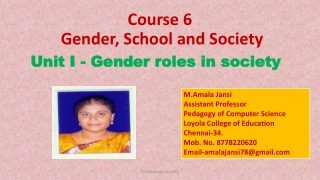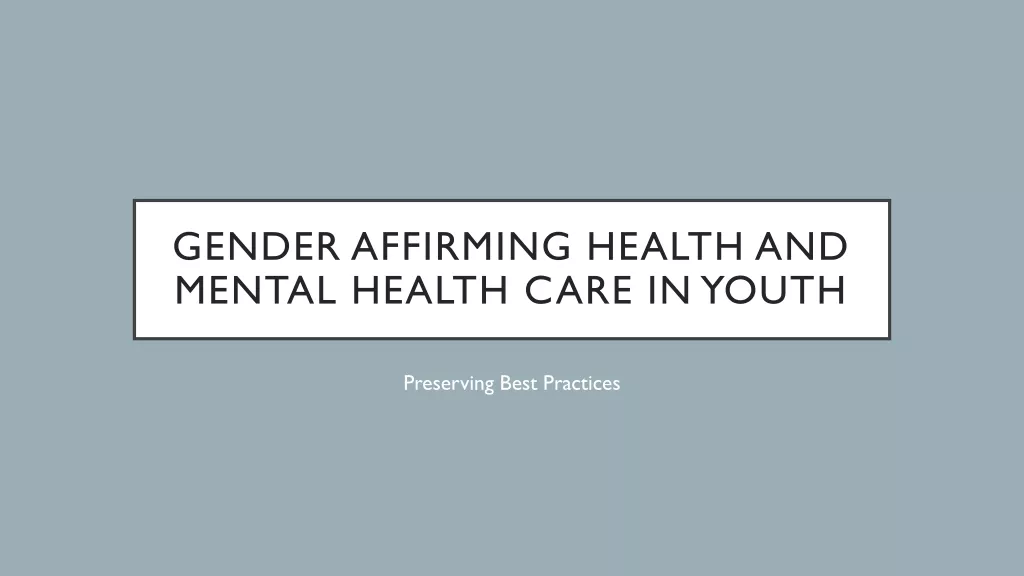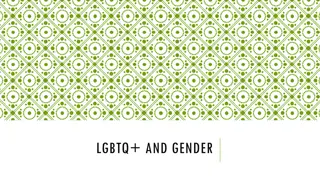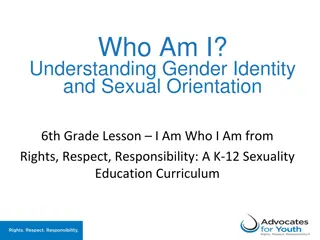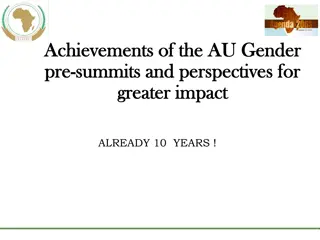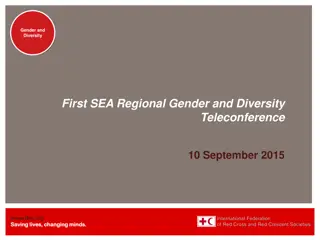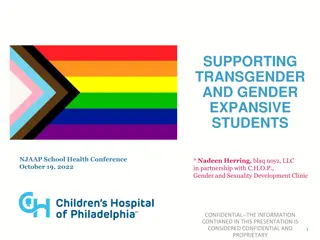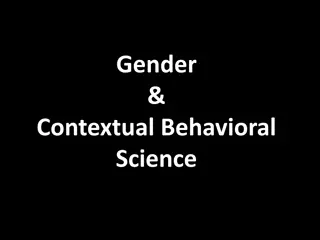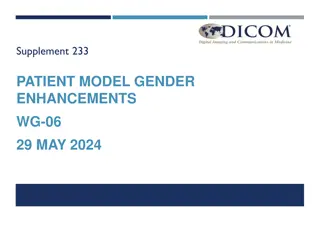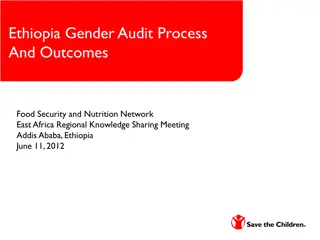Gender Representation and Diversity at ANU: Insights and Trends
ANU professional staff composition, particularly regarding gender diversity, is analyzed through various data points such as gender representation among students and staff, distribution across different roles, and percentages of female technical and administrative staff. The importance of diverse and inclusive organizations in fostering innovation, creativity, and employee satisfaction is highlighted based on research findings.
Download Presentation

Please find below an Image/Link to download the presentation.
The content on the website is provided AS IS for your information and personal use only. It may not be sold, licensed, or shared on other websites without obtaining consent from the author. Download presentation by click this link. If you encounter any issues during the download, it is possible that the publisher has removed the file from their server.
E N D
Presentation Transcript
SAGE Athena SWAN Pilot Information for ANU Professional Staff
Gender representation: all ANU students and academic staff 2016 100% 90% 80% 70% 60% 50% 40% 30% 20% 10% 0% Undergradate ex honours Bachelor's Honours PGRD HDR Level A Level B Level C Level D Level E Equivalent Female Male 2
Professional staff at ANU 58% of ANU professional staff are women. There is a greater concentration of women in entry level roles. There are fewer women in technical and research roles, and more women in admin roles. At the senior levels (SM1, SM2, SM3+ and Executive) there is now a roughly even split of men to women. 3
2018 Percent Female Technical Professional Staff 60% 50% 40% 30% 20% 10% 0% 3/4 (F&S) 4/5 (Technical) 5/6 (Technical) 6 (Technical) 7 (Technical) 8 (Technical) SM1 (Technical) 4
2018 Percent Female Admin Professional Staff 90% 80% 70% 60% 50% 40% 30% 20% 10% 0% 3 and Below 4 5 6/7 8 SM1 SM2 SM3+ EXEC 5
Diverse and inclusive organisations: are more innovative and creative 1 have higher employee satisfaction 2 have lower rates of staff turnover 3 1. Angela Ka-yee Leung, William W. Maddux, Adam D. Galinsky, and Chi-yue Chiu, Multicultural Experience Enhances Creativity: The When and How, American Psychologist, vol. 63, no. 3 (April 2008); Malcolm Higgs, Ulrich Plewnia, and Jorg Ploch, Influence of Team Composition and Task Complexity on Team Performance, Team Performance Management, vol. 11, no. 7/8 (2005); Cristian L. Dezs and David Gaddis Ross, Does Female Representation in Top Management Improve Firm Performance? A Panel Data Investigation, Strategic Management Journal, vol. 33, no. 9 (September 2012); Mariateresa Torchia, Andrea Calabr , and Morten Huse, Women Directors on Corporate Boards: From Tokenism to Critical Mass, Journal of Business Ethics, vol. 102 (2011): p. 299- 317; Toyah Miller and Mar a del Carmen Triana, Demographic Diversity in the Boardroom: Mediators of the Board Diversity Firm Performance Relationship, Journal of Management Studies, vol. 46, no. 5 (July 2009): p. 755-786; Marinova, Plantegna & Remery 'Gender Diversity and Firm Performance', Utrecht School of Economics, January 2010 2. Carrie Parks, Attention to Diversity Pays Off: A Conversation With Murat Phillipe, HR Solutions International, Inc., Bridges: Institute for Diversity in Health Management, vol. XIII, no. 4 (Fall 2007): p. 6-7; David M. Kaplan, Jack W. Wiley, and Carl P. Maertz Jr., The Role of Calculative Attachment in the Relationship Between Diversity Climate and Retention, Human Resource Management, vol. 50, no. 2 (2011); Sungjoo Choi and Hal G. Rainey, Organizational Fairness and Diversity Management in Public Organizations: Does Fairness Matter in Managing Diversity?, Review of Public Personnel Administration (May 15, 2013). 3. Kaplan, D M, Wiley, J W, & Maertz, C P (2011), The role of calculative attachment in the relationship between diversity climate and retention, Human Resource Management, 50(2), 271-287 6
Everyone benefits from a more inclusive and diverse work culture. 7
ANU is committed to creating an inclusive environment where all staff have the opportunity to reach their full potential. The ANU Strategic Plan 2018 2021 (3.1) sets a goal of achieving an Athena SWAN Bronze institutional award by 2019. 8
What is SAGE? SAGE is a national program promoting gender equity and diversity in STEMM through the Australian pilot of the Athena SWAN Charter. Established 2014, partly in response to the fact that no women were shortlisted for the Australian Academy of Science Fellowships in 2013 SAGE is run by Australian Academy of Science in partnership with the Academy of Technology and Engineering (ATSE) 10
What is Athena SWAN? The Athena SWAN Charter is an evaluation and accreditation program The Charter recognises excellence in employment practices that advance the careers of women and gender minorities To read the Ten Principles of the Athena SWAN Charter, see www.services.anu.edu.au/sage 11
While SAGE focuses on gender equity within the STEMM disciplines, ANU is committed to inclusion and diversity more broadly. As part of the SAGE Athena SWAN project at ANU, we are working towards greater equity and inclusion within all disciplines and groups of staff across the University. 12
SAGE Athena SWAN at ANU Self-Assessment Team Name Area Professor Mike Calford (Chair) Provost Professor Richard Baker Pro Vice-Chancellor University Experience Dr Nadine White Director, Human Resources Ms Richelle Hilton Director, Planning and Performance Measurement Professor Rae Frances Dean, ANU College of Arts & Social Sciences Professor Elanor Huntington Dean, ANU College of Engineering & Computer Science Professor Paul Pickering Director, Research School of Humanities and the Arts Professor Stephen Eggins Director, ANU College of Science Professor John Evans College of Science 13
SAGE Athena SWAN at ANU Self-Assessment Team (continued) Name Area Mr Jamiyl Mosley Head of Hall Burton & Garran Hall Dr Jananie William ANU College of Business & Economics Professor Steve Blackburn ANU College of Engineering & Computer Science Associate Professor Kuntala Lahiri-Dutt ANU College of Asia & the Pacific Associate Professor Mark Nolan ANU College of Law Dr Joanna Sikora ANU College of Arts & Social Sciences Associate Professor Cathy Banwell College of Health & Medicine Dr Naomi Priest ANU College of Arts & Social Sciences Ms Sarah O'Callaghan Manager, Facilities & Services Ms Sara Rowley (Project Manager) SAGE Project Manager, Human Resources 14
Project timeline Stage 1 Data profiling Consultation forums Stage 2 Existing data collected Stage 3 Additional data collected Links to colleges and research schools Stage 4 Action plan developed Stage 5 Application submission 29 March 2019 15
Gender equity progress at ANU Since joining the SAGE pilot of Athena SWAN, ANU has: Improved the gender balance in administrative executive roles - from 11% female execs in 2012 to 52% female execs in 2018 Expanded parental leave entitlements to include up to 26 weeks of paid parental leave for partners Increased funding through the Carer's Career Development Assistance Fund to support staff with caring commitments to participate in conferences or workshops Appointed a Dean of Staff, to assist staff in the early resolution of potential cases of discrimination 16
What gender inequities do you see at ANU? Are there any gender equity issues that are specific to professional staff? What changes do you want to see, to make ANU more inclusive and equitable? Contact us: SAGE@anu.edu.au Find out more: services.anu.edu.au/sage 17
Contact us: SAGE@anu.edu.au Find out more: services.anu.edu.au/sage 18



